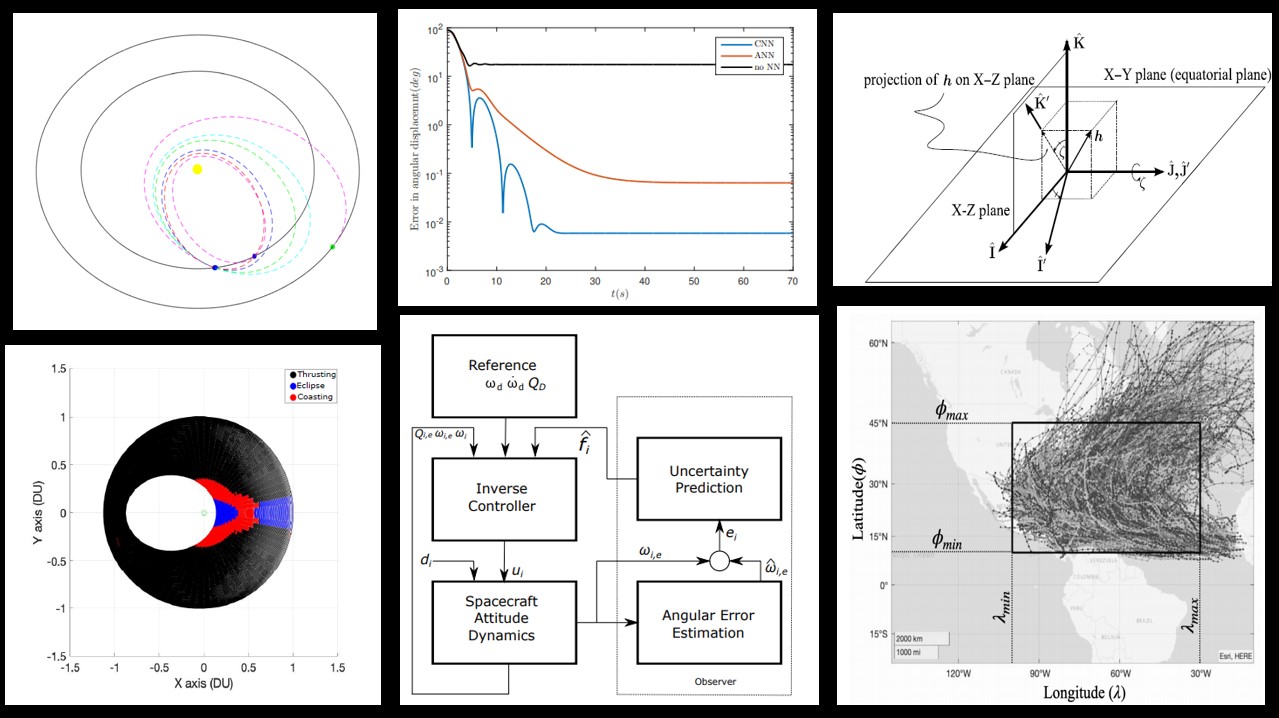Zaidi, T., Arustei, A., Munir, A., & Dutta, A. (2025). Single-Agent Attention Actor-Critic:
A Deep Reinforcement Learning-Based Solution for Low-Thrust Spacecraft Trajectory
Optimization. IEEE Transactions on Aerospace and Electronic Systems. accepted for
publication.
Zaidi, T., Arustei, A., Munir, A., & Dutta, A. (2025). Automated Trajectory Planning:
A Cascaded Deep Reinforcement Learning Approach for Low-Thrust Spacecraft Orbit-Raising.
IEEE Aerospace and Electronic Systems Magazine. doi: 10.1109/MAES.2025.3556795. https://ieeexplore.ieee.org/document/10947520
Steck, J., Arustei, A., & Dutta, A. (2025). Low Thrust Minimum Time Transfer: Single
Network Adaptive Critic Approximate Dynamic Programming. AAS/AIAA Space Flight Mechanics
Meeting. Kauai, HI. AAS 25-311.
Arustei, A., Dutta, A (2024). Direct Optimization of Low-Thrust Orbit-Raising Maneuvers using
Adjoint Sensitivities,. Acta Astronautica. Vol. 219, pp. 965-981. https://doi.org/10.1016/j.actaastro.2024.03.059
Pillay, Y., Chace, M., Steck, J., Watkins, J., and Dutta, A (2024). Neuro-adaptive
Model Reference Tracking Controller for Cislunar Missions. AIAA Guidance Navigation and Control Conference,
AIAA SciTech Forum, Orlando FL. AIAA 2024-0509. https://doi.org/10.2514/6.2024-0509
Dutta, A., Arustei, A., Chace, M., Chadalavada, P., Steck, J., Zaidi, T. & Munir,
A (2024). Machine
Learning Assisted Low-Thrust Orbit-Raising: A Comparative Assessment of a Sequential
Al-
gorithm and a Deep Reinforcement Learning Approach (2024). AAS/AIAA Space Flight Mechanics Meeting, AIAA SciTech Forum. Orlando FL. AIAA 2024-1669. https://doi.org/10.2514/6.2024-1669
Zaidi, A., Chadalavada, P., Ullah, H., Munir, A., and Dutta, A (2023). Cascaded Deep
Reinforcement
Learning-Based Multi-Revolution Low-Thrust Spacecraft Orbit-Transfer. IEEE Access,
vol. 11, pp. 82894-82911, https://ieeexplore.ieee.org/document/10207710.
Fry, C. A (2023). An Exploration of Solar Radio Flux Forecasting Using Long Short-Term
Memory Artificial Neural Networks. MS Thesis, University of Kansas.
Dasyam, A., Dutta, A (2023). Artificial Neural Network based Atmospheric Density Model
for Aerobraking Trajectory Design. AAS/AIAA Space Flight Mechanics Meeting. Austin TX.
Mughal, A., Chadalavada, P., Munir, A., Dutta, A., & Qureshi, M (2022). Design of
deep neural networks for transfer time prediction of spacecraft electric orbit-raising.
Elsevier Intelligent Systems with Application. Vol. 15, Article No 200092. https://doi.org/10.1016/j.iswa.2022.200092
Pillay, Y., Chace, M., Steck, J., & Dutta, A (2022). Neural network for predicting
unmodelled dynamics in multi-revolution transfers in cis-lunar missions. AAS/AIAA Astrodynamics Specialist Meeting. Charlotte, NC.
Arustei, A., Dutta (2022), A. An adjoint sensitivity method for the sequential low-thrust
orbit-raising problem. AAS/AIAA Astrodynamics Specialist Conference. Charlotte NC.
Fry, C., McLaughlin, C (2022). Optimizing Long Short-Term Memory Neural Network to
Forecast Solar Radio Flux. AAS/AIAA Astrodynamics Specialist Conference. Charlotte NC.
Dasyam, A., Chadalavada, P., Fry, C., Dutta, A., & McLaughlin, C (2021). Neural Network
Based Estimation of Atmospheric Density during Aerobraking. AAS/AIAA Astrodynamics Specialist Meeting. Held virtually.
Pillay, Y., Chace, M., Messick, K., Steck, J., & Dutta, A (2021). Modified State Observer
for Characterization of Unmodeled Dynamics in Cis-lunar Missions. AAS/AIAA Astrodynamics Specialist Meeting. Held virtually.
Chadalavada, P., Dutta, A., & Ghosh, P (2021). An Efficient Algorithm for the Longitude-Targeted
Ascent of All-Electric Satellites. AAS/AIAA Space Flight Mechanics Meeting (AIAA Scitech Forum). San Diego CA.
Farabi, T., & Dutta, A. (2021). Artificial Neural Network Based Prediction of Solar
Array Degradation during Electric Orbit-Raising. AAS/AIAA Space Flight Mechanics Meeting. Virtual Conference. AAS 21-424.


